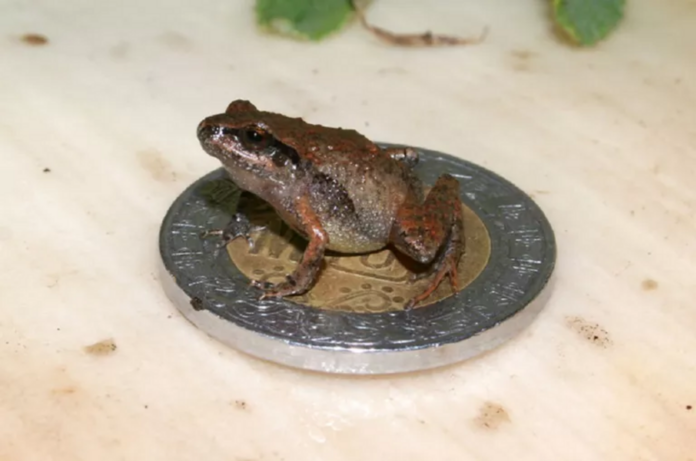Six new tiny frog species discovered in Mexico
Newly discovered Craugastor Cueyatl sits on a Mexican 10 pesos coin .
These small frogs could play a huge role in the ecosystem.
The itty-bitty creatures were hiding in plain sight.
Researchers have uncovered six new species of minuscule frogs that are smaller than the size of a dime. The frogs had previously been spotted and collected but never identified.1
The frogs are part of a group called Craugastor, which are very difficult to tell apart. Until this discovery, they have gone unnoticed because they are all brown and look so similar to other frogs, says Tom Jameson, a researcher at the University of Cambridge’s Department of Zoology and University Museum of Zoology, who led the study.2
The newly identified frogs were in museum specimen collections.
“The six new species were sitting in collections labeled as unknown Craugastor of thought to be maybe Craugastor pygmaeus or Craugastor hobartsmithii (the other two very small Craugastor from Mexico),” Jameson tells Treehugger.
“They had been classified as this because previous scientists could tell they were in this group, but since they all look very similar they couldn’t tell exactly where they fit.”
The research team revisited how the frogs were classified because study co-author Jeff Streicher of the University of Texas at Arlington and the Natural History Museum in the United Kingdom had done genetic analysis in 2012 that suggested there were many undescribed species.2
This time around, scientists followed up with a more detailed genetic analysis.
For the study, researchers looked at nearly 500 frog specimens from museums all over the world and used novel methods to categorize their relationships. The frogs had been collected in Mexico.1
Scientists used DNA sequencing to sort the frogs based on the similarity of their genes. Then they created 3-D models of the frogs’ skeletons so that they could compare physical attributes to one another. Using these two methods, they found six new frog species.1
The results were published in the journal Herpetological Monographs.
Tiny Frogs with a Huge Role
These small frogs are interesting for so many reasons, the researchers say.
“What I think is so fascinating about these frogs is their tiny size. When frogs get this small they stop really behaving like frogs and aren’t really filling a normal frog role in an ecosystem. When they are this small, frogs are filling an ecological role much more similar to insects,” Jameson says.
The six newly found species are all smaller than a dime—about 18 millimeters in diameter—when fully grown.32
“These frogs have probably evolved to be so small to allow them to live their lives in forest leaf litter. Living in this wet forest leaf-litter ecosystem provides a host of advantages for an animal, giving access to prey hidden in its depths and shelter from predators, with a high humidity to prevent drying out.”
Although they are tiny, the frogs can potentially play a huge role in the forest ecosystem.
“Some of the frogs in this group (for example, the widespread Craugastor pygmaeus) are potentially hyper abundant, with many millions of them filling the leaf litter of the forests in which they live,” Jameson says.
“This huge biomass makes them incredibly important in the food chain, potentially forming the foundation upon which the whole forest ecosystem is built. Lots of other animals will be using them as a food source: Lizards, small mammals, birds, other frogs, and even insects. Without these frogs, the whole ecosystem collapses.”
Some of the newly identified frogs may be found only in one small location, such as one hilltop in Mexico.1
“Many of the newly discovered species are probably microendemics, meaning they only occur in one tiny area. This means if this area is destroyed or damaged, for example by deforestation or pollution then the whole species could be snuffed out,” Jameson says.
“Our findings are important because we can only protect a species if we know it exists in the first place. As part of our work, we identified protected areas in and around where the newly described species occur. This means we can tell if the species already have some level of protection or if they are completely without it. Based on these findings we recommended the expansion and connection of existing protected areas and the formation of new protected areas.”
The new species have been named Craugastor bitonium, Craugastor candelariensis, Craugastor cueyatl, Craugastor polaclavus, Craugastor portilloensis, and Craugastor rubinus.1
Craugastor rubinus was named for the garnet mines located on the hillside where the frogs live.1 Jameson says expanding just one mine could wipe out these frogs forever.
Researchers believe there are more species of Craugastor that have yet to be identified.
“As part of this study, we investigated where people had gone in the past to look for Craugastor in Mexico. We found that there are huge areas of Mexico with suitable habitat where we would expect to find Craugastor frogs and probably new species, but no one has looked there yet,” he says.
“I can almost guarantee that there are new species of Craugastor awaiting discovery in the Sierra Madre de Chiapas and on the slopes of the Sierra Madre del Sur and Trans-Mexican Volcanic Belt that make up the watershed of the Balsas River. All we need to do is go and find them.”
Fact checked by Haley Mast

